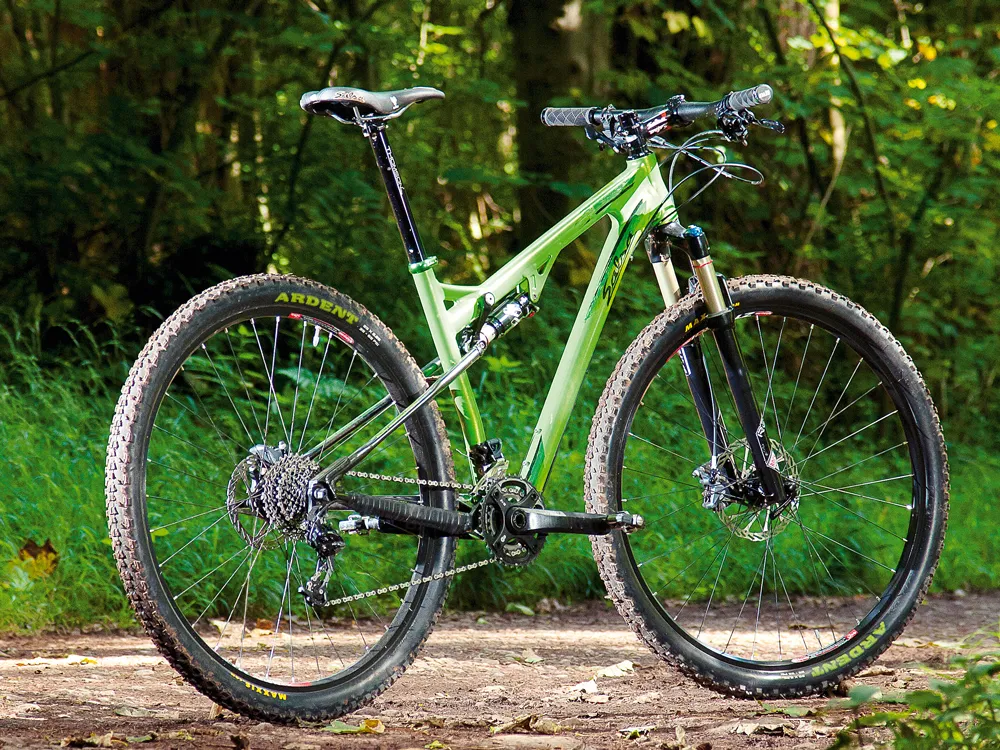Salsa say they designed the Spearfish 29er “for 24-hour and other ultra-endurance cross-country efforts”. After a month of regular test rides we’d say that makes good sense, but it felt just as at home being subjected to quick blasts on our local woodsy singletrack.
There, its easy-going handling, pedal efficiency and big wheel steamroller-over-everything gait tames terrain to a point where you appear to be riding slower but are actually going faster than on a similarly equipped, similar weight 26er. It’s a bike that seems to calm everything down, releasing concentration to focus on simple pleasures of pedalling, steering and absorbing your surroundings.
Ride & handling: Easygoing, with big wheel steamroller-over-everything gait
29ers have been around for a few years, but people still ask us what the advantages are. Most pros and cons compared to 26in-wheeled bikes are so minor that they effectively equal out in overall performance. But bikes like the Spearfish emphasize one big difference that’ll make you love it. Or not, as the case may be.
Its silky-smooth rolling rhythm and ease of handling mean it’s easier to ride than a similarly equipped 26er. That may not suit riders who like to bob, weave and manhandle their bike along, but for those who just like to smooth their way over every trail with minimum fuss, easy traction and maximum rolling efficiency, the Spearfish delivers handsomely.
With a suspension compression that starts with a falling rate, rising slightly at the end of the stroke, the Salsa offers a supple ride over tiny bumps. This is emphasized if you choose to fit big volume tubeless tyres and run them at relatively low pressures. The 2.4in treads we tried half way through the test period wouldn’t quite fit under the seatstay bridge: the 2.25in Maxxis Ardents fitted to our test rig are the sensible limit of the frame clearances, although it’s possible that this may change on the later production models.
The rising rate of the suspension when it gets close to full compression means that the occasional top out on square edged hits is inevitable if you’re riding hard. It’s a reminder that there’s only 80mm of travel, but it feels more like a tyre compression than the hard knock that some other suspension systems suffer from. Even riding hard and fast on rooty and rocky terrain rarely seems to challenge its limits.
That said, as with most other short travel full sussers you’ll probably find yourself riding the Spearfish more like a hardtail, slightly unweighting the rear wheel to stop it from kicking up as it closes on the 80mm travel limit on hard edged bumps rather than slamming through as you might on a longer travel bike. Hovering over the saddle on the really bumpy stuff allows you to keep the power on and you soon notice that pedal efficiency in acceleration or on climbs, sitting or standing, is excellent. We certainly never felt the need for any sort of platform damping in the shock.
Frame: Tough but lightweight build
It’s named after the town of Spearfish in the Black Hills of South Dakota, home to the Dakota Five-O race and 100s of miles of singletrack that Salsa says, “this bike will excel on”. While there’s a new breed of slacker angled longer travel big wheelers evolving, this is a bike that sits in between the race bikes and the big terrain bikes. It’s designed to be easy to ride even when you’re dog-tired and your reflexes are fading.
The single-pivot EV-6 Extralite frame uses custom heat-treated hydroformed aluminium tubes to achieve a tough but lightweight build: a medium frame tips the scales at just over 5.5lb (2.5kg). It has a rocker activated RockShox Monarch air shock and offers 80mm of rear wheel travel. It’s assumed that most riders will choose a 100mm travel fork.
Weight and maintenance are kept to a minimum by using tube profiles that allow a tiny amount (about 5mm) of flex in the rear triangle rather than using pivots at the drop-outs. A short tapered (1.125/1.5in) head tube with integrated headset cups keep the front low and adds steering precision while SRAM’s Press-Fit 30 bottom bracket (BB) trims a few extra grams as well as aiding drive train efficiency.
The 71-degree head, 73-degree seat angles help keep handling neutral and the compact mainframe leaves loads of standover clearance. The finishing detail is excellent, with sealed cartridge bearings at all pivots, a Cane Creek hidden headset, Salsa’s own seat collar and under-down tube full outer cable guides doubling up as frame protection against flying debris from the front tyre. The downside of this is that cleaning is a little more fiddly after muddy outings.
Equipment: Buy the Spearfish as a frame alone or build your own 29er
We imagine most riders will buy the Spearfish as a frame alone. Our test bike came with a RockShox Reba RL fork, a relatively low weight Stan’s ZTR Arch rim/SRAM hub wheelset shod with beefy but fast rolling Maxxis Ardent treads plus SRAM X9 gears and cranks; bear in mind your crank choice will be limited by SRAM’s Press-Fit bottom bracket. Finishing kit was mainly Salsa branded.
The complete bike weight was approximately 27.5lb, without pedals. If we were to change anything, we’d opt for a fork and front wheel with a thru-axle for more precise steering. It’s no big deal, but 29er wheels flex a little more than 26ers because of the longer spokes, and a bolt-thru axle goes some way to correcting that.




